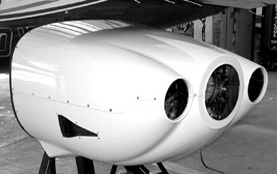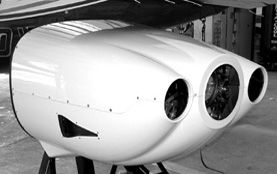
For many owners of Pipers Malibu Mirage, the experience can best be described as schizophrenic. On the one hand, the airplane is comfortable, fast and a delightful long-distance traveling machine. On the other, its Lycoming TSIO-540-AE2A has proven cantankerous, fuel-thirsty, hot running and unlikely to make claimed TBO without major mid-time work.
If that rocky marriage between a terrific airframe and a maintenance-hungry engine sounds like the perfect aftermarket fix-up project, thats exactly how Enhanced Flight Group looks at it. EFG has undertaken and will soon market a range of pricey upgrades to the Mirage that, if they deliver, should fundamentally reshape the airplanes performance and reliability.
EFG, based in Lexington, Kentucky, is the creation of Jonathan Sisk, a Mirage owner who tired of the airplanes considerable powerplant shortcomings and decided to do something about it. Sisk is an electrical engineer and principal of a company called Audio Authority, which builds showroom demonstration equipment for the consumer electronics trade.
Sisk is overseeing what he calls the Magnum Mirage modification series and hes enlisting some of the best mod and STC shops in the country to help with engineering and development.
These mods arent, however, for the timid wallet. Sisk estimates that a wholesale firewall-forward remake of the Mirage-which is what this project amounts to-will cost in the range of $150,000.
But we wont be surprised if many Mirage owners, already disgusted with lack of dispatch reliability and alarmed at Lycomings most recent crankshaft crisis, will consider that sum a worthy investment.
Whats Planned
We recently visited EFGs Sisk in Lexington and were given a summary of Magnum Mirage planned mods. Its a long list and as ambitious a redo of any aircraft as weve seen in recent years.
Engine modified with high-compression pistons, improved fuel injection/servo and GAMIjectors to improve thermal efficiency.
Improved intercoolers.
Reinforced engine mount.
Improved instrumentation STC.
Landing gear speed fairings.
Redesigned cowling and baffling.
Four-blade prop with longer spinner.
In his research before planning the Magnum project, Sisk surveyed owners and learned that the Mirages high fuel consumption is a leading negative; poor fuel economy eats into range and payload and reduces the airplanes utility.
Further, to protect their expensive engines, many owners run at reduced power settings, sapping the Mirages speed advantage. In addition, Sisk found that many of the Mirages engine woes are heat related, due to inefficient cooling.
To attack the efficiency issue, EFG will offer an overhauled TSIO-540-AE2A with 8.7-to-1 compression ratio pistons rather than the 7.3-to-1 versions used in the stock engine. The engine will be built by Barrett Performance Aircraft in Tulsa, Oklahoma, a respected shop.
Lower compression pistons have traditionally been used in turbocharged engines to provide an easy engineering solution to building in detonation margin. But Sisk says with additional intercooling, the improved cowling and by establishing lower CHT and TIT limits as a condition of the STC, the Magnum overhaul can run higher compression pistons and still have adequate detonation margins.
To that end, EFG has invested a great deal of research in a new carbon-fiber cowling with tuned inlets, reworked baffling and re-designed intercoolers that offer more cooling area but are still drop-in replacements for the originals. Sisk told us that EFGs research found that the Mirages stock cowling has larger inlets than the Magnum version but cooling air is poorly regulated in the original.
The Magnum version moves the inlets away from the prop and a new spinner and even a mini-spinner on the air conditioner compressor smoothes turbulence around the inlets. This also reduces cooling drag and improves cruise speed, says Sisk.
With less turbulent airflow through the cowling, Sisk believes the typical heat-related problems with the number 5 cylinder and wide CHT spreads most Mirages suffer will be corrected. In an aircraft flown at low altitude, marginal cooling might not be an issue but above 18,000 feet, where the Mirage often ventures, cooling efficiency drops dramatically due to lower air density. At high altitude, Sisk found that the cylinders need all the cooling help they can get and the new cowl is designed to provide it. Sisk says early testing of the cowling and related hardware indicates that cooling drag is reduced sufficiently to increase cruise speed into the 225-knot range, up from about 213 knots at 75 percent power at high altitude in the unmodified Mirage. Fuel flow is a thirsty 24 GPH.
Presumably, an owner could throttle back and enjoy a still-respectable cruise speed but at lower fuel flow, thus substantially improving range and extending economy.
To further improve economy, EFG will provide power settings for both rich-of-peak and lean-of-peak operations. Sisk says the goal is to give owners enough information to operate the engine in either lean mode and let them decide for themselves which is more suitable. In either case, Sisk intends that the Magnum mods will eliminate the self-imposed restrictions many owners fly under in the name of engine preservation.
New Mirages are equipped with an instrument called an Enhanced Digital Indicator for engine management but Sisk believes JPIs engine analyzers are a better choice and EFG will pursue an STC to make the JPI standard, along with a re-located and improved TIT probe. Older Mirages-1995 and earlier-have a TIT gauge and the JPI would legally replace that instrument.
Last, the EFG mod will include an improved engine mount. Because of forces on the nosegear, which is directly attached to the engine mount, the structure cracks predictably around a welded tube in the lower portion of the mount. The EFG mod-which entails a rework of the existing mount-would replace the problem tube with a thicker-walled part.
Conclusion
Mirage owners are justifiably nervous about the reliability, utility and continued market value of their expensive airplanes. And that was before the current crankshaft recall. On paper, EFGs mods would appear to address all of the firewall-forward issues of the Mirage and it looks to us as though the Magnum project has the potential to transform the airplane into what Piper (and owners) hoped it always would be.
That said, all weve done is talk to Jon Sisk about this project; we havent flown a Magnum Mirage. Sisk expects to have approvals for most if not all of his project STCs by the end of 2003. Some-the cowling, engine mount and landing gear fairings-may be sold piecemeal. But the engine mods probably wont be, since the modified engine will need the improved cooling of the Magnum cowl to perform to its full potential.
As for the full-up price of about $150,000, that could represent as much as 40 percent of the value of an older Mirage or half that percentage for a newer one. But some owners are so desperate to improve dispatch reliability that we think Sisk will find a market.
And if the mods deliver as he claims, the Magnum project could restore much of the fleets lost value. We suspect most Mirage owners are familiar with the EFG project but we think anyone contemplating a Mirage purchase should look into these mods before buying. They look promising to us.
Contact- Enhanced Flight Group: 2048 Mercer Road, Lexington, KY 40511; 859-255-4511; www.enhancedflight.com.


